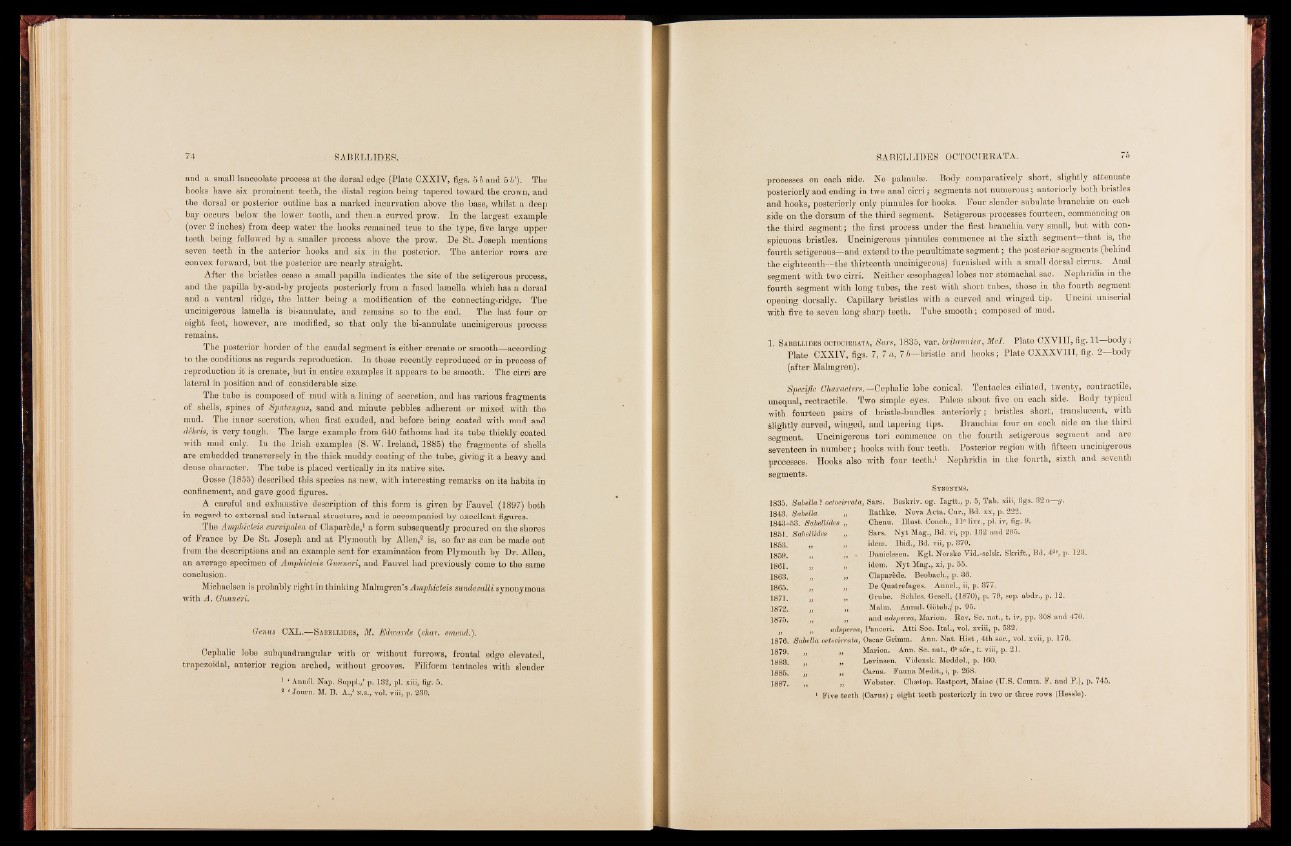
and a small lanceolate process at the dorsal edge (Plate CXXIV, figs. 5 b and 5 b'). The
hooks have six prominent teeth, the distal region being tapered toward the crown, and
the dorsal or posterior outline has a marked incurvation above the base, whilst a deep
bay occurs below the lower tooth, and then, a curved prow. In the largest example
(over 2 inches) from deep water the hooks remained true to the'type, five large upper
teeth being followed by a smaller process above the prow. De St. Joseph mentions
seven teeth in the anterior hooks and six in the posterior. The anterior rows are
convex forward, but the posterior are nearly straight.
After the bristles cease a small papilla indicates the site of the setigerous process,
and the papilla by-and-by projects posteriorly from a fused lamella which has a dorsal
and a ventral ridge, the latter being a modification of the connecting-ridge. The
uncinigerous lamella is bi-annulate, and remains so to the end. The last four or
eight feet, however, are modified, so that only the bi-annulate uncinigerous process
remains.
The posterior border of the caudal segment is either crenate or smooth—according
to the conditions as regards reproduction. In those recently reproduced or in process of
reproduction it is crenate, but in entire examples it appears to be smooth. The cirri are
lateral in position and of considerable size.
The tube is composed of mud with a lining of secretion, and has various fragments
of shells, spines of Spatangus, sand and minute pebbles adherent or mixed with the
mud. The inner secretion, when first exuded, and before being coated with mud and
débris, is very tough. The large example from 640 fathoms had its tube thickly coated
with mud only. In the Irish examples (S. W. Ireland,“ 1885) the fragments of shells
are embedded transversely in the thick muddy coating of the tube, giving it a heavy and
dense character. The tube is placed vertically in its native site.
Gosse (1855) described this species as new, with interesting remarks on its habits in
confinement, and gave good figures.
A careful and exhaustive description of this form is given by Fauvel (1897) both
in regard to external and internal structure, and is accompanied by excellent figures.
The Amphicteis curvipalea of Claparède,1 a form subsequently procured on the shores
of France by De St. Joseph and at Plymouth by Allen,® is, so far as can be made out
from the descriptions and an example sent for examination from Plymouth by Dr. Allen,
an average specimen of Amphicteis Gunneri, and Fauvel had previously come to the same
conclusion.
Michaelsen is probably right in thinking Malmgren’s Amphicteis sundeualli synonymous
with A. Gunneri.
Genus CXL.—Sabellides, M. Edwards {char, emend.).
Cephalic lobe subquadrangular with or without furrows, frontal edge elevated,
trapezoidal, anterior region arched, without grooves. Filiform tentacles with slender
1 ‘ Ann61. Nap. Suppl./ p. 132, pi. xiii, fig. 5.
9 ‘ Journ. M. B. A./ n.s., vol. viii, p. 230.
processes on each side. No palmulae. Body comparatively short,, slightly attenuate
posteriorly and ending in two anal cirri; segments not numerous; anteriorly both bristles
and hooks, posteriorly only pinnules for hooks. Four slender subulate branchiae on each
side on the dorsum of the third segment. Setigerous processes fourteen, commencing on
the third segment; the first process under the first branchia very small, but with conspicuous
bristles. Uncinigerous pinnules commence at the sixth segment—that is, the
fourth setigerous—and extend to the penultimate segment; the posterior segments (behind
the eighteenth—the thirteenth uncinigerous) furnished with a small dorsal cirrus. Anal
segment with two cirri. Neither oesophageal lobes nor stomachal sac. Nephridia in the
fourth segment with long tubes, the rest with short tubes, those in the fourth segment
opening dorsally. Capillary bristles with a curved and winged tip. Uncini uniserial
with five to seven long sharp teeth. Tube smooth; composed of mud.
1. Sabellides octocirrata, Sars, 1835, var. britannica, Mcl. Plate CXVIII, fig. 11 body;
Plate CXXIV, figs. 7,7 a, 7 b—bristle and hooks ; Plate CXXXVIII, fig. 2—body
(after Malmgren).
Specific Characters.—Cephalic lobe conicai. Tentacles ciliated, twenty, contractile,
unequal, rectractile. Two simple eyes. Palese about five on each side. Body typical
with fourteen pairs of bristle-bundles anteriorly; bristles short, translucent, with
slightly curved, winged, and tapering tips. Branchiae four on each side on the third
segment. Uncinigerous tori commence on the fourth setigerous segment and are
seventeen in number; hooks with four teeth. Posterior region with fifteen uncinigerous
processes. Hooks also with four teeth.1 Nephridia in the fourth, sixth and seventh
segments.
Synonyms.
1835. Sabella ? octodn'ata, Sars. Beskriv. og. Iagtt., p. 5, Tab. xiii, figs. 32 a—g.
1843. Sabella „ Rathke. Nova Acta. Cur., Bd. xx, p. 222.
1843-53. Sabellides „ Chenu. Ulust. Conch., IIe livr., pi. iv, fig. 9.
1851. Sabellides „ Sars. Nyt Mag., Bd. vi, pp. 132 and 205.
1853. „ » idem. Ibid., Bd. vii, p. 370.
1859. „ ,V* Danielssen. Kgl. Norske Yid.-selsk. Skrift., Bd. 4de, p. 123.
1861. „ „ idem. Nyt Mag., xi, p. 55.
1863. „ » Claparède. Beobach., p. 36.
1865. .,, „ De Quatrefages. Annel., ii, p. 377.
1871. „ » Grube. Schles. Gesell. (1870), p. 79, sep. abdr., p. 12.
1872. „ „ Malm. Annul. Göteb./ p. 95.
1875. „ „ and adspersa, Marion. Rev. Sc. nat., t. iv, pp. 308 and 470.
,, adspersa, Panceri. Atti Soc. Ital., vol. xviii, p. 532.
1876. Sabella octocirrata, Oscar Grimm. Ann. Nat. Hist., 4th ser., vol. xvii, p. 176.
1879. „ „ Marion. Ann. Sc. nat., 6e sér., t. viii, p. 21.
1883. „ „ Levinsen. Vidensk. Meddel., p. 160.
1885. „ „ Cams.- Fauna Médit., i, p. 268.
1887. „ „ Webster. Chætop. Eastport, Maine (U.S. Comm. F. aud F.), p. 745.
1 Five teeth (Carus) j eight teeth posteriorly in two or three rows (Hessle).